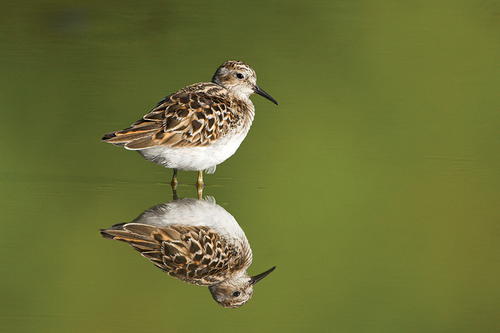Peeps
These sandpipers are almost lookalikes. So look closely.

A least sandpiper strikes a reflective pose.
Peeps—it’s a cute name that makes bird-watchers shudder. These peeps aren’t the mushy-sweet duck-shaped marshmallows that hatch on store shelves around Easter—they are a group of brown-and-gray, sparrow-sized birds that gather by the hundreds of thousands at favorite mudflats during migrations. Like the sweet peeps, when sandpipers gather en masse they are hard to tell apart. Even experts are baffled. One paper published in the American Birds journal warned that “these species are extremely similar to one another and usually require considerable previous experience, exceptional viewing conditions, and a healthy amount of patience to identify correctly.” That’s not an optimistic view for the average bird-watcher.
Three of the most challenging to identify are the least sandpiper (Calidris minutilla), the semipalmated sandpiper (Calidris pusilla), and the Western sandpiper (Calidris mauri). There are differences and clues to identification among the species, but they are subtle. Least sandpipers have a smaller and very slightly downcurved bill; Western sandpipers have a heavier, longer bill; and semipalmated sandpipers (not to be confused with semipalmated plovers) are somewhere in between. Semipalmated and Western sandpipers also have black legs, while the least’s are yellow. That’s a great help with identification, until the birds start engaging in their favorite pastime—feeding in black mud.
Peeps look alike and their life cycles are similar. They spend their winters feeding and loafing in the sunny south. Western sandpipers enjoy the Pacific coast from Washington to Peru; semipalmated sandpipers jump over the Atlantic Ocean in a nonstop flight from Canada to South America and the mudflats of Brazil; and the least sandpipers stick to the southern United States and Mexico. But these are not hard-and-fast rules. Birds have wings, so they can show up anywhere. A few Western sandpipers spend their winters along the Atlantic and some least sandpipers like the shores of the West Coast.
Read NextHidden Treasures



